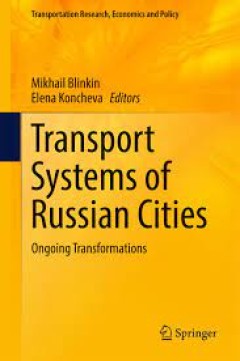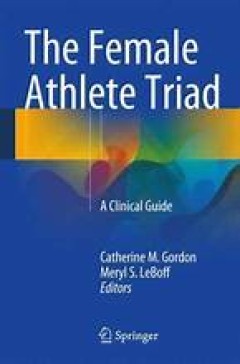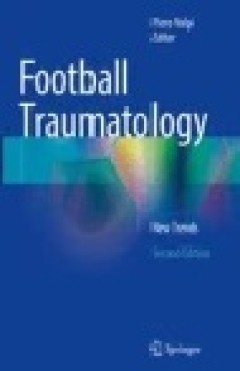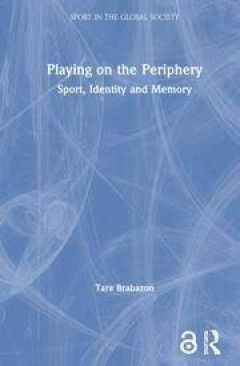Filter by

Transport Systems of Russian Cities Ongoing Transformations
This volume discusses post-socialist urban transport functioning and development in Russia, within the context of the country’s recent transition towards a market economy. Over the past twenty-five years, urban transport in Russia has undergone serious transformations, prompted by the transitioning economy. Yet, the lack of readily available statistical data has led to a gap in the inclusion …
- Edition
- -
- ISBN/ISSN
- 978-3-319-47800-5
- Collation
- -
- Series Title
- -
- Call Number
- -

The Female Athlete Triad
This is the first book of its kind to focus solely on the female athlete triad - its origins, its recognition, and most importantly, its management. Since the symptoms themselves cover a range of medical specialties, chapters are written by experts in a number of relevant fields - sports medicine, orthopedics, endocrinology, and pediatrics - with an eye toward overall care of the young female a…
- Edition
- 1
- ISBN/ISSN
- 978-1-4899-7525-6
- Collation
- XI, 182, 9 b/w illustrations, 13 illustrations in colour
- Series Title
- -
- Call Number
- -

The end of automobile dependence
In this publication, Newman and Kenworthy look at how we can accelerate a planning approach to designing urban environments that can function reliably and conveniently on alternative modes. They consider a refined and more civilized automobile playing a very much reduced and manageable role in urban transportation. The authors examine the rise and fall of automobile dependence using updated dat…
- Edition
- 1
- ISBN/ISSN
- 978-1-61091-613-4
- Collation
- XIV, 308, 49 b/w illustrations
- Series Title
- -
- Call Number
- -

Traffic and Random Processes An Introduction
This book deals in a basic and systematic manner with the fundamentals of random function theory and looks at some aspects related to arrival, vehicle headway and operational speed processes at the same time. The work serves as a useful practical and educational tool and aims at providing stimulus and motivation to investigate issues of such a strong applicative interest. It has a clearly discu…
- Edition
- -
- ISBN/ISSN
- 978-3-319-09324-6
- Collation
- -
- Series Title
- -
- Call Number
- -

Towards Functional Safety in Drive-by-Wire Vehicles
This book presents approaches to address key challenges based on a vehicle level view and with a special emphasis on Drive-by-Wire systems. The design and testing of modern vehicle electronics are becoming more and more demanding due to increasing interdependencies among components and the safety criticality of tasks. The development towards Drive-by-Wire functionalities in vehicles with multip…
- Edition
- -
- ISBN/ISSN
- 978-3-319-17485-3
- Collation
- -
- Series Title
- -
- Call Number
- -

Therapy of the Hand and Upper Extremity Rehabilitation Protocols
Presenting over 100 rehabilitation protocols for the hand and upper extremity in an easy-to-use, step-by-step format, this practical reference provides surgeons and therapists alike with a go-to source for the therapy technique or strategy appropriate for their patients. Covering injuries from the shoulder, elbow, wrist, hand and fingers, each protocol includes bullet-pointed steps in daily or …
- Edition
- -
- ISBN/ISSN
- 978-3-319-14412-2
- Collation
- -
- Series Title
- -
- Call Number
- -

Football Traumatology: New Trends
This book provides a comprehensive guide to the evaluation, treatment, and rehabilitation of musculoskeletal injuries commonly experienced by football (soccer) players. It will be of particular value for orthopedists and sports medicine practitioners, and will provide the information required by trainers and medical staff regarding the traumatic lesions associated with the sport. It is also ant…
- Edition
- -
- ISBN/ISSN
- 978-3-319-18245-2
- Collation
- XV, 392 hlm.
- Series Title
- -
- Call Number
- -

Sports law and policy in the European Union
The commercialisation of sport in Europe raises important questions concerning the most appropriate method of regulating sporting activity. The development of the European Union and the internationalisation of sporting competition has added an international dimension to this debate. Yet sport is not simply a business to be regulated in the same way as any other industry. It is also a social and…
- Edition
- -
- ISBN/ISSN
- 9780719066061
- Collation
- -
- Series Title
- -
- Call Number
- 340 PAR s

Decision support for crew rostering in public transit : web-based optimizatio…
While traditionally sequential approaches have been used to deal with the cyclic/non-cyclic crew rostering problem in public transit, Lin Xie focuses on several solution approaches based on a novel network design to solve this task within one step. This is due to the fact that sequential planning often produces some unassigned duties that require additional drivers to cover them, while some dri…
- Edition
- -
- ISBN/ISSN
- 9783658081676
- Collation
- -
- Series Title
- -
- Call Number
- 380.5

Playing on the Periphery Sport, Identity and Memory
Part of the Sport in the Global Society series, this innovative and creative text explores collective history, memory, and sport culture, tracking the passage of sports away from England. The author investigates why ‘elite’ English sports – such as rugby and cricket – became national sports in New Zealand and Australia, and asks why ‘working class’ English sports – such as footbal…
- Edition
- -
- ISBN/ISSN
- 9780203099100
- Collation
- -
- Series Title
- -
- Call Number
- -
 Computer Science, Information & General Works
Computer Science, Information & General Works  Philosophy & Psychology
Philosophy & Psychology  Religion
Religion  Social Sciences
Social Sciences  Language
Language  Pure Science
Pure Science  Applied Sciences
Applied Sciences  Art & Recreation
Art & Recreation  Literature
Literature  History & Geography
History & Geography